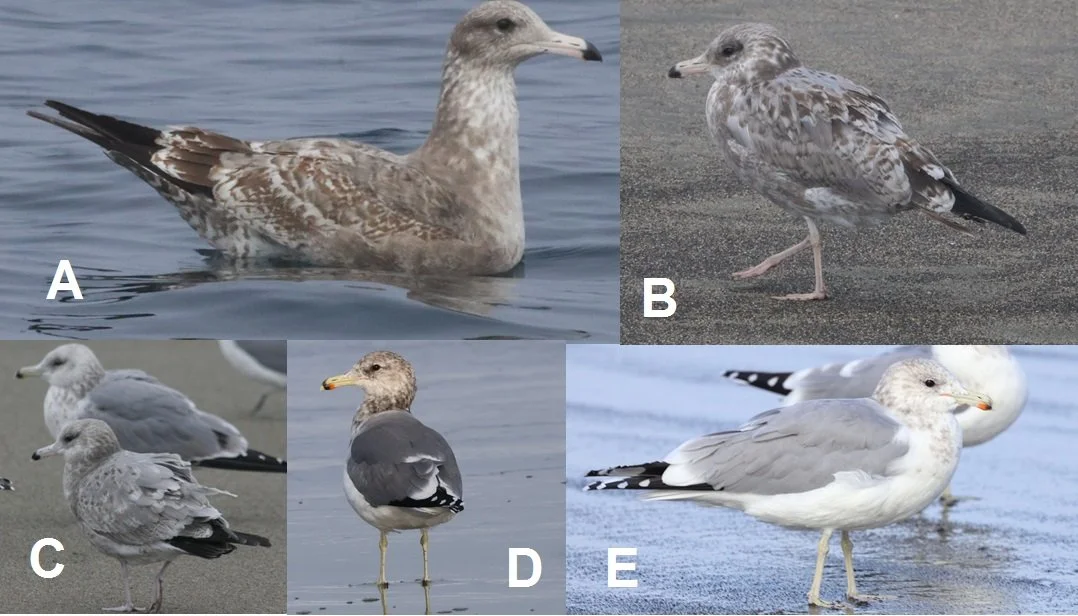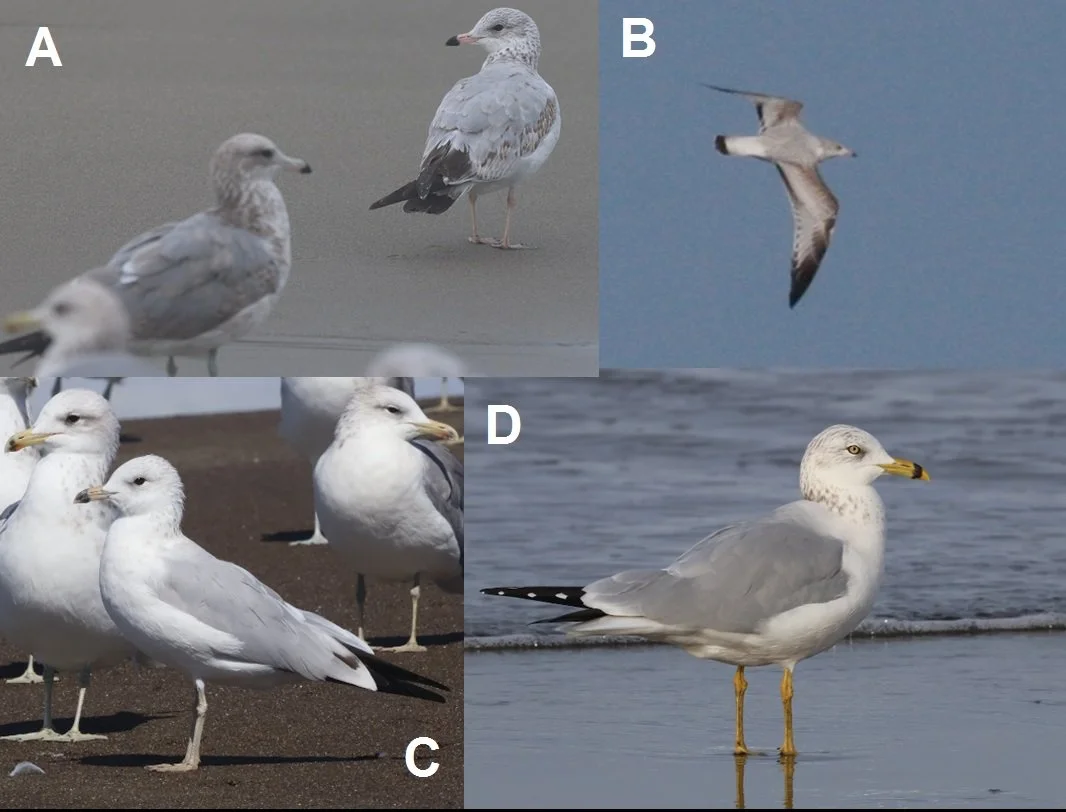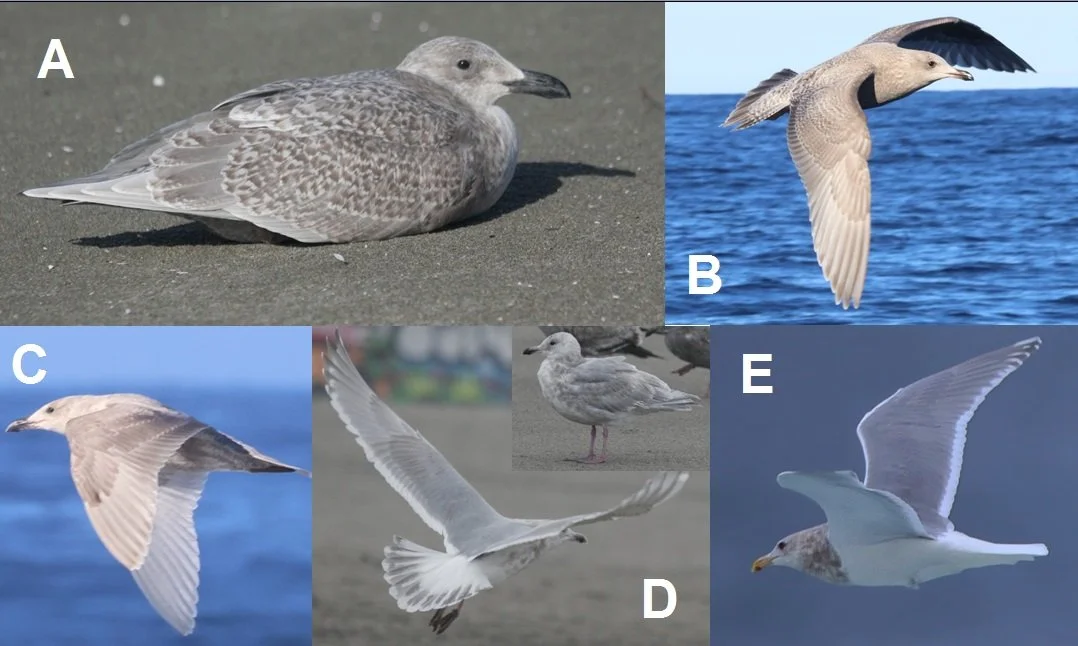Mendo Gulls, Part 3. October-November
This is the third in a series of gull identification and aging along the Mendocino coast. See the May Issue of the Oystercatcher for an introduction to this series and coverage of gulls along the Mendo coast during March-June, and the Summer Issue for coverage during July-September. In the figures below we will continue to track Western and California gulls following completion of their prebasic molts (that includes primaries) and initiation of their preformative and prealternate molts of body feathers and wing coverts, and we will cover two of our migrant and wintering species here, Ring-billed and Glaucous-winged Gulls; next month will tackle additional wintering species: American Herring, Thayer’s, and Short-billed Gulls. As in previous installments, all photos were taken along the central California coast (SF-Mendocino) in October through November or in some cases late September or December.
Figure 1. Non-adult Western Gulls (WEGUs) in October-November
Again an adult is not shown as these look remarkably the same year round; one thing to note is that their heads remain pure white during October-November, unlike all other adult gulls in these months. Among the younger age classes, first-cycle birds (A, 11 Nov) appear like slightly faded juveniles but commence molt of back feathers during what we call the preformative molt.
These feathers can be dark gray as in this bird. First-cycle WEGUs remain easy to separate from all other regular gulls along the coast here due to their overall dark brown coloration and their large completely black bills.
Second-cycle birds show the most variation of the age classes, depending on both plumage and the amount of back-feather molt during what we call the second prealternate molt. The browner ones (B, 9 Nov) can be similar to first-cycle birds but are paler headed, have less evenly checkered (more “muddied”) wing coverts, begin to get some adult-like gray feathers in the back, and usually have pink bases to the bills. More advanced second-cycle birds (C, front bird, 5 Nov) can get more gray in the back by November but continue to show brown wing coverts and a mostly black bill. The rump is whiter than in first-cycle birds but the tail remains mostly dark (E, 9 Nov).
Third cycle WEGUs (C, back bird and D, 5 Nov) are more adult-like than second-cycle birds, including the wing coverts, but show some brown or blackish in the wings and black coloration to the bill. In flight (F, 5 Nov) the tail shows a black band or series of spots, and the white “mirrors” to the outer two primaries are absent or reduced compared with those of adults. The large size, dark gray adult-like back feathers, and large bills with these patterns helps us identify WEGUs in these plumages.
Figure 2. California Gulls (CAGUs) in October-November.
CAGUs follow very similar plumage sequences by age as WEGUs, though progression toward adult plumage is slightly more advanced. First-cycle birds (A, 14 Oct) are juvenile-like except that grayer formative feathers come in on the back. Note the highly checkered brown wing coverts, typically bolder than in WEGUs (cf. Fig. 1A), but not showing the grayer and muddier coloration of second-cycle CAGUs (B, 27 Oct), which by early December can also be replaced by adult-like alternate feathers.
(C, in front of an adult, 10 Dec). Unlike in WEGUs, the bill is bright pink at the base with a clean black tip. Note that the tail remains dark in second-cycle birds and leg color can remain pale pink in CAGUs through their second fall, although some begin to get a yellowish, bluish, or greenish tinge.
As in WEGUs, third-cycle CAGUs (D, 7 Dec; see also Fig. 3A) are adult-like except for more brown in the head and wings, black in the bill, and (although not visible here) a black band or spots in the tail as in 3rd-cycle WEGUs (cf. Fig. 1F). By this age the legs become yellow as in adults.
This adult (E, 9 Nov) typifies CAGUs of this age in fall, showing a medium-gray back (paler than WEGU but darker than that of most of our winter visitors), yellow legs, and characteristic CAGU bill pattern with both a red and a black spot near the tip.
Figure 3. Ring-billed Gulls (RBGUs) in October-November.
RBGUs are not very common on our coast, preferring fresher water at more inland Mendocino localities; visiting birders that don’t know this frequently misidentify CAGUs for RBGUs. In all cases, RBGUs are smaller and paler on the back than respective ages of CAGUs. They also mature in plumage more quickly, most reaching adult plumage in the third cycle. Compare, for example, the first-cycle RBGU in A (right, 28 Sep) with the third-cycle CAGU at left, similar in plumage although the juvenile wing coverts in the RBGU are checkered instead of mostly gray. It has already replaced most of its back feathers with more adult-like formative feathers, paler than in CAGU at all ages. The tail in first-cycle RBGUs is white at the base with a dark subterminal or terminal band (B, 27 Oct), rather than all dark as in second-cycle CAGUs, and note the increased amount of black in the upperwing feathers at this age than in our other gulls.
The bird in C (27 Sep, with adult CAGUs) is probably an advanced second-cycle bird although it could be a slow-maturing third-cycle bird; the pinkish bill base and pinkish-yellow leg color suggests the former. Its plumage is almost as adults except note some black in the tertials, and the ring of the bill is not yet expressed; instead, its black tip can be confused with the bill pattern of a younger CAGU but these have more brown in the plumage than second-cycle RBGUs.
Adult RBGUs (D, 7 Dec) have the characteristic ring around the bill and note also the brighter yellow legs in fall and winter, and the paler iris, dark at all ages of CAGU.
Figure 4. Glaucous-winged Gulls (GWGUs) in October-November
In size, structure, and bill color, GWGUs are similar to WEGUs. First-cycle birds (A, 14 Dec and B, 27 Nov) can vary overall from rather whitish to olive-brown, but in all cases can be separated from WEGUs by their paler primary tips - these are not pure white but can look fairly so in the field (pure white tips are found in Glaucous Gulls which we will cover at a later date). Note also the checkered wing coverts, as in 1st-cycle WEGUs, that become muddier by the second cycle (C, 3 Dec).
As in WEGU, bill color remains entirely to mostly black through the second fall and, again as in WEGUs, third-cycles (D, 6 Dec) are much more adult-like but can show brownish in the wings, a grayish subterminal tail band or spots, and continued dark to the bill. As mentioned above, the wing tips are not white but in third-cycles and adults (E, 23 Dec, photo by Lisa Walker) show a WEGU-like pattern, with the dark portions grayish rather than black. Note the mottled head and neck in adults, not found in adult WEGUs.
As we know and shudder to think, hybrids between WEGU and GWGU are common; basically we look for various combinations of in-between plumage characters but not those of structure and bill. We’ll cover hybrids in a future figure.




